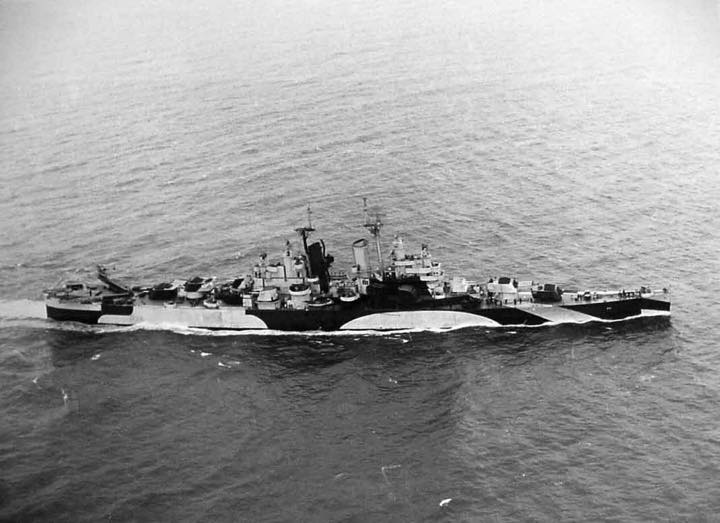USS Miami CL-89

Miami II (CL-89: dp. 10, 000; 1. 610'1"; b. 66'4"; dr 20'; s. 33 k.; cpl. 992; a. 12 6", 12 5", 2S 40mm., 10 20mm., cl. Cleveland )
The second Miami(CL-89) was laid down 2 August 1941 by Cramp Shipbuilding Co., Philadelphia, Pa. launched 8 December 1942; sponsored by Mrs. C. H. Reeder, wife of the mayor of Miami, Fla., and commissioned 28 December 1943, Capt. John G. Crawford in command.
After shakedown in the Caribbean and training along the Atlantic coast, the new light cruiser, accompanied by Vincennes (CL-64) and Houston. (CL-81), departed Boston 16 April 1944 for the Pacific, via the Panama Canal and San Diego, reaching Pearl Harbor 6 May. Miami Joined the Fast Carrier Task Force for airstrikes in June against Saipan, Tinian, Rota, Guam, Pagan, and the Bonin Islands in support of the Marianas campaign.
During July Miami operated west of the Marianas with the carriers as they gave close air support to ground forces struggling to take the islands. Early in August she supported raids on Iwo Jima and Haha Jima in the Bonins before steaming to Eniwetok for upkeep. Her carriers hit Peleliu and Angaur in the Palaus, 7 September, and bombed targets in the Philippines from the 12th through the 15th. During these strikes her scout planes on four occasions rescued American pilots who had been shot down in enemy waters. The cruiser continued to support strikes against the Palaus and the Philippines until returning to Saipan on the 29th for replenishment.
Miami departed Ulithi for strikes on Okinawa 10 through 14 October. While her task group was under air attack on the night of 12 to 13 October, Miami's guns brought down their first enemy plane and assisted in splashing another. Planes from her carriers hit targets on Luzon 18 October.
The tempo of the Pacific war was now rising rapidly. On the 20th the 7th Fleet landed General MacArthur on the shores of Leyte fulfilling his pledge to the Philippines: "I shall return." Realizing the decisive strategic importance of the Philippines Archipelago, Japan mustered all her force for a major counter offensive to turn back the invasion. Her still formidable navy converged on Leyte Gulf from three directions: a northern force steamed above Luzon to lure the 3d Fleet north and out of the action, a center force debouched through San Bernadino and followed the coast of Samar toward Leyte and a southern force emerged through Surigao Strait to trap and destroy the amphibious ships in the gulf.
The American Navy parried these thrusts in four historic actions collectively known as the Battle for Leyte Gulf. Operating with Rear Adm. Gerald F. Bogan's Carrier task group, Miami protected carriers Intrepid (CV11), Hancock (CV-19), and Bunker Hill (CV-17) and light carriers Cabot (CVL-28), and Independence (CVL22) during the titanic struggle. Planes from the flattops located and heavily attacked the Japanese center force in the Sibuyan Sea 24 October sinking Japan's super battleship Mushashi and so damaging heavy cruiser Myoko as to force her to retire from action. The whole Japanese center force turned back to regroup, leading Admiral Halsey to conclude that they were retiring for good.
When word of the northern force off Luzon arrived that afternoon, Halsey ordered the carriers to speed north to attack. Miami accompanied them at flank speed as the flattops sank four Japanese carriers and several supporting ships. When Halsey learned that the center force had again reversed course and had steamed through San Bernadino Strait to threaten the American amphibious ships off the beachhead at Leyte, he ordered Bogan's group south to, the rescue However, the Japanese Goliaths of the center force were stopped and turned back by a handful of American Davids, three destroyers, four DE's, and six escort carriers. Nevertheless, Miami and her consorts managed to catch Japanese destroyer Nowaki off the entrance to San Bernadino Strait. With the guns of the other cruisers and destroyers, Miami's six inchers sank her.
After participating in carrier strikes on the Philippines during November, Miami encountered a typhoon while operating east of Luzon 18 December. During the morning one of the ship's aircraft was carried away, and in the afternoon her hull was damaged by buckling. As the storm abated the next day, she searched for survivors of damaged and lost ships.
On January 1946 the ship operated in airstrikes on Formosa, Luzon, French Indochina, South China Coast Hainan, and Hong Kong. She transited Balintang Channel, Luzon Straits, 20 January 1945, and the next day, while engaged in an airstrike against Formosa, Miami sighted a "Zeke" type enemy plane above the formation and shot it down. On 1 February the ship steamed close to Japan for airstrikes against targets in the Tokyo area. In mid-March Miami, began operating east of Okina\va, and continued in that area, encountering frequent enemy air opposition, until late in April.
Leaving Ulithi on 10 May 1945, touching Pearl Harbor on the 17th, Miami proceeded to the United States for overhaul, arriving San Francisco, 24 May where she remained until after the cessation of hostilities, returning to Pearl Harbor On 2., August. In September and October Miami; operated in the Ryukus accepting the surrender of the small islands north of Okinawa. After a brief visit to Yokosuka. Japan, . She steamed to the Carolines and arrived Truk 11 November to conduct a survey of bombing damage to the famous naval base there.
Ordered home 23 November, Miami arrived Long Beach 10 December. She operated on the California coast training naval reservists until decommissioning 30 June 1947 and entering the Pacific Reserve Fleet. Miami's name was struck from the Nay list 1 September 1961 and her hulk vas sold for scrapping to Nicholia Joffe Corp., Beverly Hills, Calif., 20 July 1962.
Miami received six battle stars for World War II service
 >
>